Binarysoft is Authorised Tally Sales & Implementation Partner in India
+91 742 877 9101 or E-mail: tally@binarysoft.com 10:00 am – 6: 00 pm , Mon-Fri
Binarysoft is Authorised Tally Sales & Implementation Partner in India
+91 742 877 9101 or E-mail: tally@binarysoft.com 10:00 am – 6: 00 pm , Mon-Fri
Call CA Tally HelpDesk +91 9205471661, 8368262875

If you manually enter any data into TallyPrime by referring to transaction details available any external software, you can directly import the data from such software into TallyPrime. TallyPrime allows you to import data from both Excel and XML files in a few simple steps. Importing data from Excel is based on mapping of data from Excel to the fields in TallyPrime, using the templates for mapping. At the same time, if your data is available in XML files, through import, TallyPrime reads the XML data and migrates it into relevant fields in TallyPrime.
Import Data to update Books of Account in TallyPrime: Let’s consider some business scenarios where data is maintained in external software:
Entering such data into TallyPrime manually could be very time-consuming and could lead to unnecessary errors. Use the Import feature to move all such data into TallyPrime and keep your books of accounts updated and compliant. Worried that the data to be imported might be incomplete or incorrect? You can record the exceptions while importing data and resolve the errors in the data with necessary correction, from a single report.
Import Data for Reconciliation: If your business involves payments through bank, you will need to reconcile your bank statements with your payments recorded in TallyPrime. The Import feature also allows you to import bank statements for bank reconciliation purpose. Similarly, before filing your returns, you will certainly want to reconcile the GST portal data with your books of account. Import the returns from the portal before filing, reconcile the data with the books of account, make necessary changes to your data, and proceed with filing the returns.
The import feature in TallyPrime helps in making data entry faster and ensuring that your data in books is accurate as per the bank and portal records.
We understand that your data is critical to your business. TallyPrime is designed to ensure that the Import process is easy and takes necessary steps to move your data accurately. However, you might want to configure the Import process in TallyPrime depending on your data or business practices.
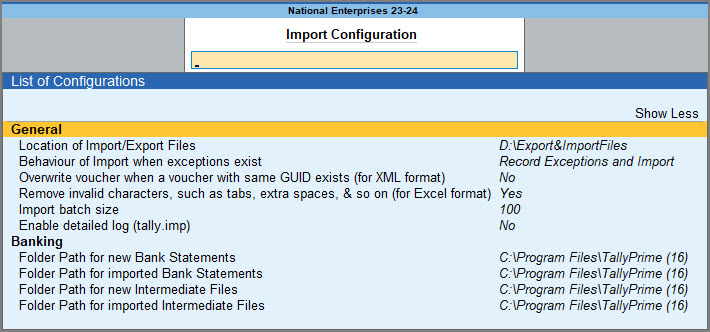

Setting up TallyPrime for importing your data ensures your data is moved from Excel or XML files into TallyPrime according to your business requirements.
This option is applicable from TallyPrime Release 4.0. Maintaining data in different Excel files, and consolidating them to update your books of accounts, audit, or reconcile can be quite tedious. TallyPrime provides you with Sample Excel Files that are in-line with the TallyPrime fields for data entry. Simply export the required Sample Excel File in TallyPrime, record all the required data in the file, and save the file with a name as you want. You are all set to import the data now.
If you are on Release 3.0.1 or earlier, importing data from Excel files is not applicable.
In this section
In TallyPrime 4.0, you can export Sample Excel File for masters or transactions depending on your needs. Each sample file includes a set of worksheets, where each worksheet is structured to enter information in-line with the corresponding field names in TallyPrime.
Say you need the Sample Excel File for importing masters.
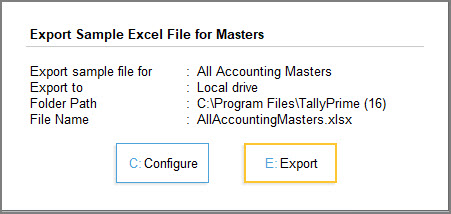

Similarly, you can export the Sample Excel File for other masters or transactions depending on your needs.
Use Sample Excel File to record data
Before recording data in the Sample Excel Files, let’s understand how to use the files.
Each Sample Excel File contains a pair of worksheets:
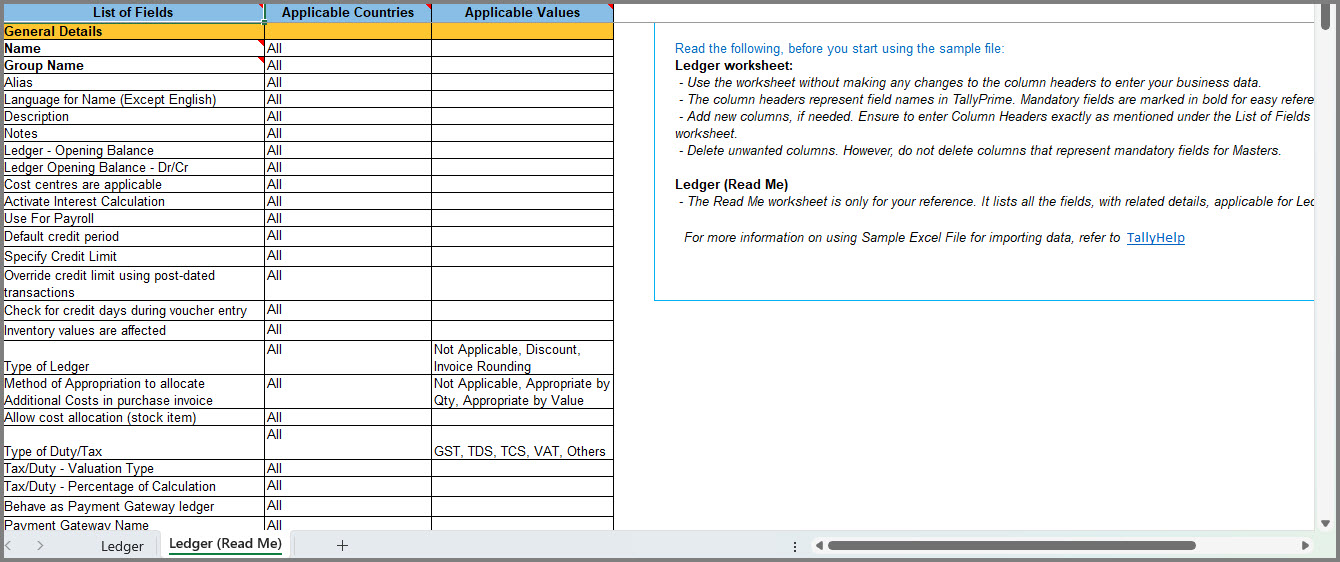
Once you are familiar with the Sample Excel File, record the data as per the required column headers in the file. In case of the ledger:
Once you have entered all necessary details for ledgers in the Sample Excel File, you can use the same next to import the ledger data into TallyPrime.
The sample files enable you to keep record of your data in the way similar to how you would enter data in TallyPrime. Importing data from Sample Excel Files is very simple. Let’s consider that you need to import the ledger-related data from the Sample Excel File > Worksheet (Ledger).

Depending on the Import configurations you have set, TallyPrime imports the data successfully. The use of Sample Excel Files helps in easily importing data into TallyPrime without any manual entry.
T0 refer to some sample data, click here to download.
This is applicable from TallyPrime Release 4.0. Your business practices might require you to record transaction details in different ways. Say you maintain data such as your party details, tax details, or expense details in Excel worksheets. Similarly, you might have recorded all the sales, purchase, payments and so on in Excel worksheets with all the necessary information. It is quite normal that you would maintain these worksheets the way it is convenient for your business. If you use this data in TallyPrime to update your Books of Account and ensure that your data is compliant for returns filing or reconciliation purposes, you can use the Import feature in TallyPrime to import the data, by creating simple-to-use mapping templates. These mapping templates help you to map your data in Excel files with the TallyPrime fields.
In this section
Before importing data from Excel, you might need to ensure that your company data or the Excel file has the related or dependent information, for a smooth import experience. In certain cases, you need to verify the configuration in the company. In the absence of required supporting details, the imported data may get into exceptions or the import process might not be successful.
Ensure availability of dependent masters before importing vouchers
For example:
Ensure availability of dependent configurations in the company
For example:
Update Excel data with other related and required information
For example:
While importing vouchers in case you need to import details, such as buyer/supplier details, ensure that such details are:
Update Excel data with field-level mandatory details
For example:
While importing Standard Rate and Standard Selling Price details, ensure that you have provided the Applicable From field in the Excel file and mapped for the relevant field in TallyPrime.
Create and save a template by mapping the data from your Excel sheet with the fields in TallyPrime. You can use this template while importing data from the corresponding Excel file so that the data gets imported based on the mapping you have created.
Create Mapping Templates for Masters

Say you maintain all the stock item details of your company for the financial year or quarter-wise in a worksheet named Sheet1 in the Excel file named Item List.xlsx. Let’s consider the following sample data for ease of understanding:
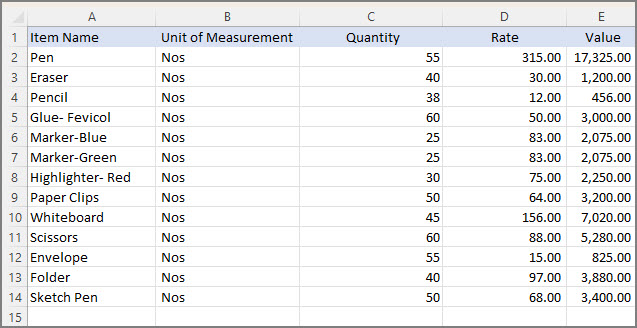
Now, let’s create a mapping template for the sample data shown in the image:

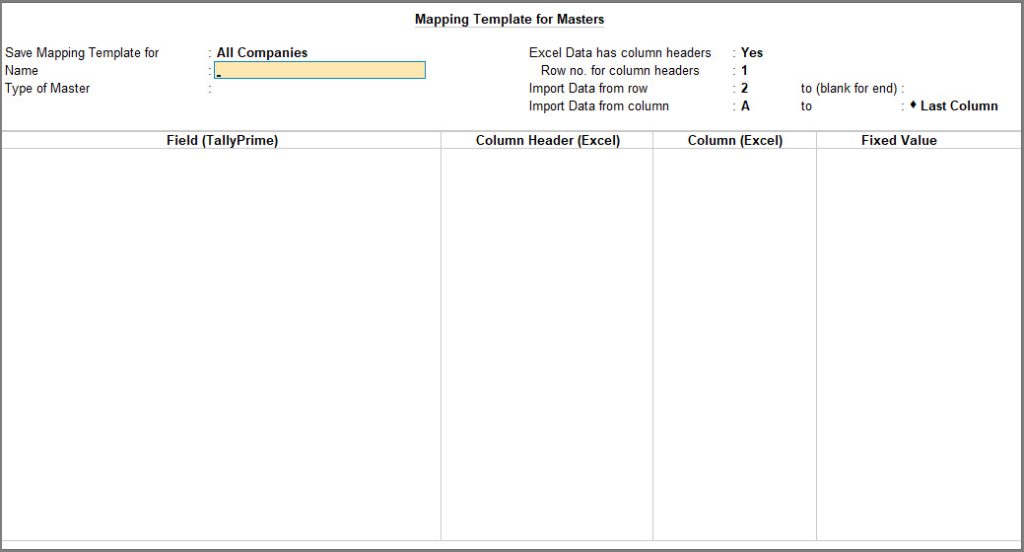
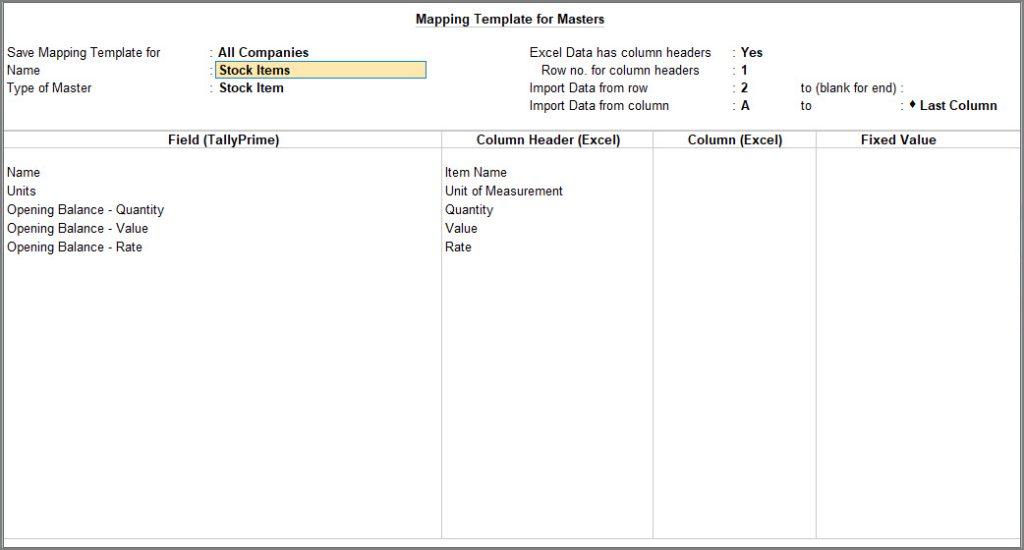
Save the mapping template. As always, press Ctrl+A to save.
The template gets saved under the config > excelmaps folder available under the folder where your TallyPrime application is installed. You can use this template next time you import data from the Sheet1 worksheet.
You are now ready to import the data anytime from that Excel worksheet, using the mapping template created for master. When you import the master data, TallyPrime by default creates masters based on unique ledger names from the Excel worksheet.
Need to map data, reuse the saved templates, or even configure the mapping templates further based on your preferences? No worries! TallyPrime provides a host of flexible options to configure and use mapping the way it suits your data needs. To know more, refer to the Mapping Options Based on Types of Data in Excel section.
Create Mapping Templates for Transactions

Say you maintain all your sales-related details of your company for the financial year or quarter-wise in a worksheet named Sales Bills in the Excel file named Sales Transactions Q1.xlsx. Let’s consider the following sample data for ease of understanding:
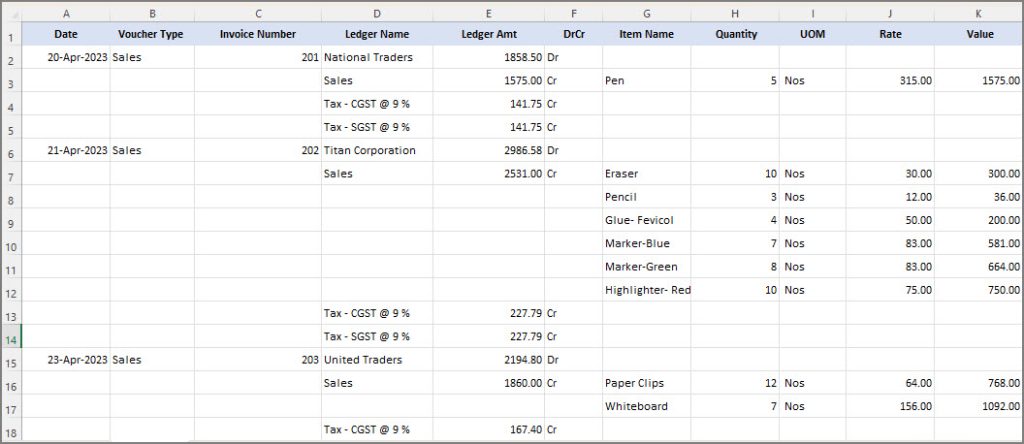
Now let’s create a mapping template for the sample data shown in the image:


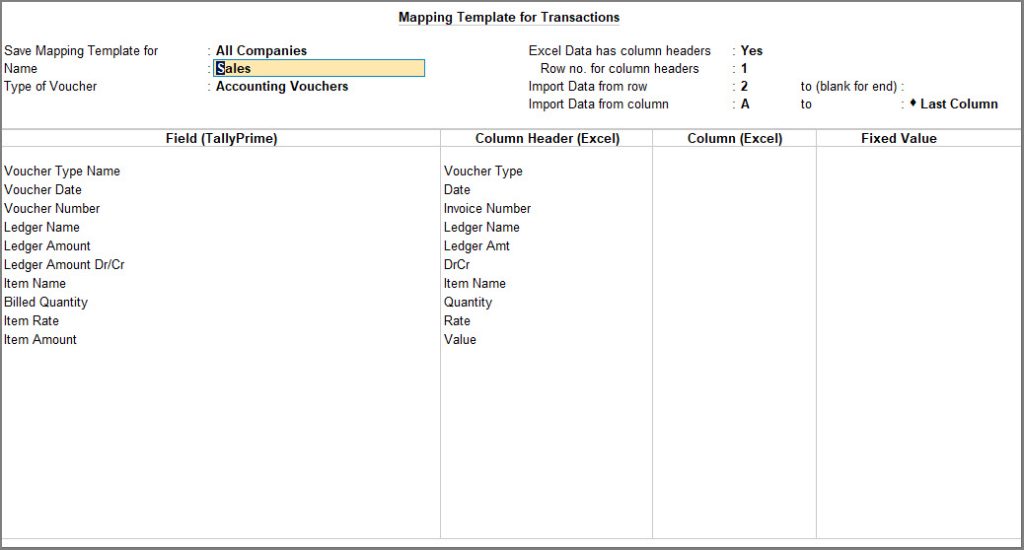
You are now ready to import the data anytime from that Excel worksheet, using the mapping template created for transactions. By default, the mapping template considers creating vouchers based on Voucher Type Name, Voucher Date and Voucher Number found in the Excel worksheet. In case you need to configure the mapping template to set the way the vouchers should be created, TallyPrime provides you the additional flexibilities.
T0 refer to some sample data and corresponding Mapping Templates, click here to download.
Mapping of data using Ledger Entry Details from Multiple Rows
You may have the voucher details of different parties entered in multiple rows in your Excel file.
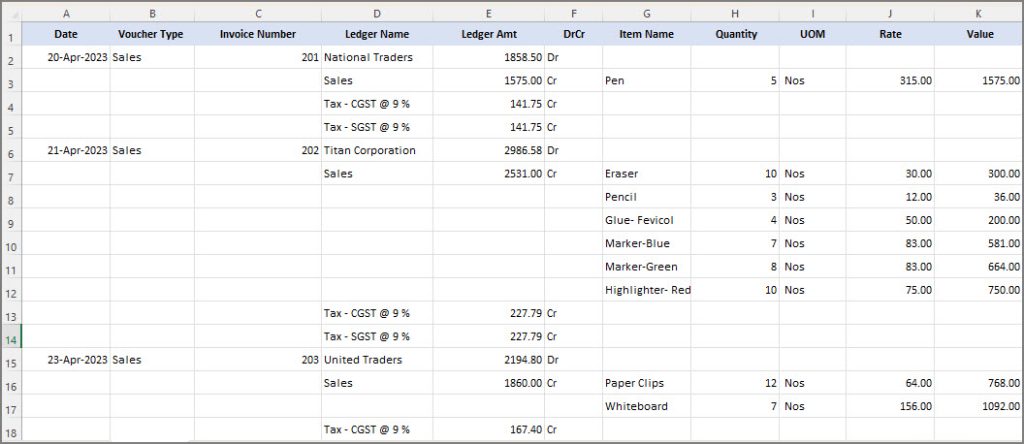
You can use the Ledger Details from Multiple Rows option in the mapping template to easily import this data into TallyPrime.
In the Mapping Template Creation screen,
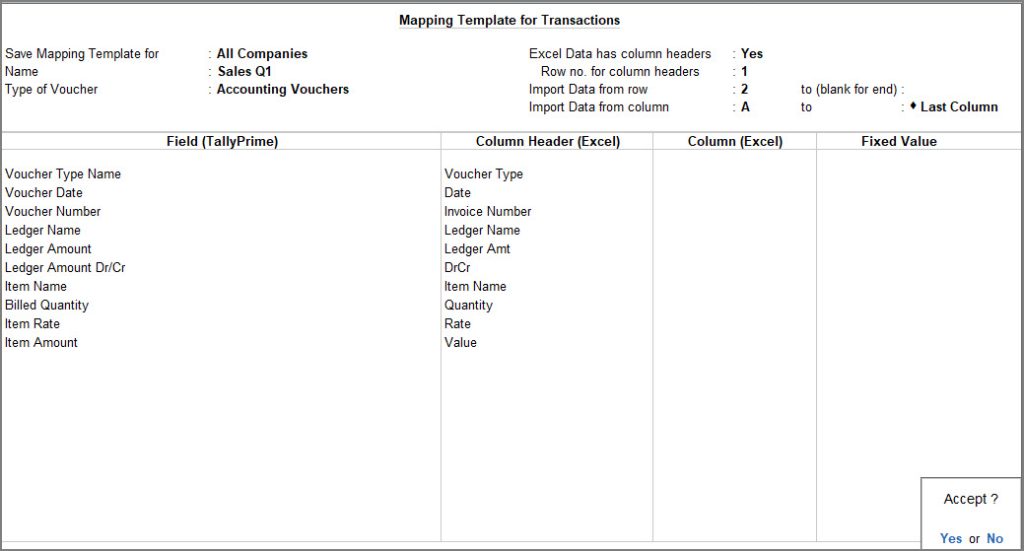
Mapping of top and bottom entries in vouchers using Ledger Entries from Fixed Columns
You may have entered the details of the sales vouchers in multiple columns in your Excel file. You may have entered the top ledger and bottom ledger details of the sales vouchers in different columns in your Excel sheet.

You can use the Ledger Entries from Fixed Columns option in the mapping template to easily group and import this data into TallyPrime.
In the Mapping Template Creation screen,
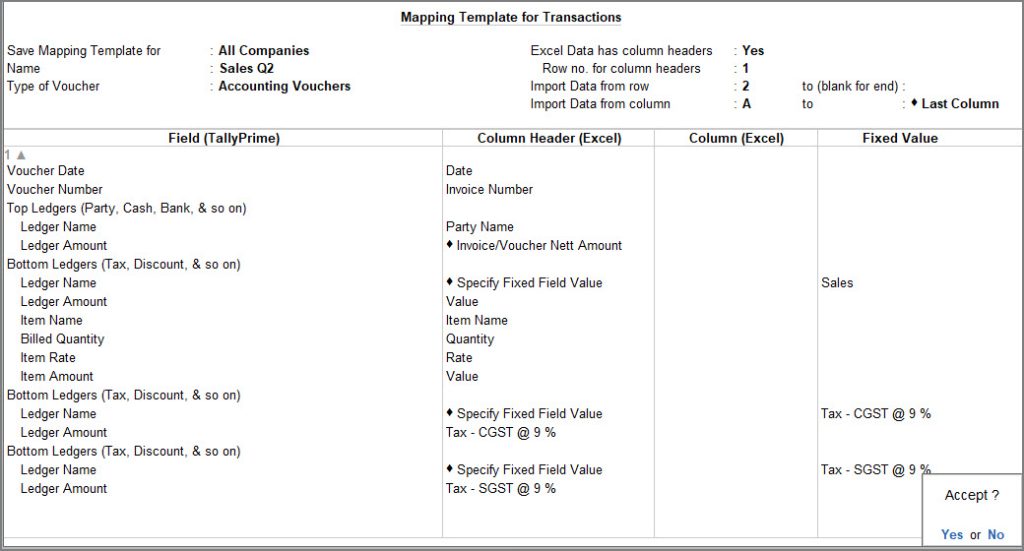
After saving the template, you can use the same to import your transactions into TallyPrime. View the Day Book to view the imported transactions in TallyPrime.
Download Mapping Templates for data entries applicable in e-commerce businesses
You also have the option to download Excel worksheet with prefilled column headers and templates already mapped to the worksheet.
The following table lists the sample files that can be used for recording data, especially if you are into e-commerce or online retail industries.
| Serial No. | E-commerce/ Other Software | Zip Files |
| 1. | Amazon | Amazon B2B |
| 2. | Busy | Busy |
| 3. | Marg | Marg |
| 4. | Odoo | Odoo |
| 5. | QuickBooks Desktop | QuickBooks Desktop |
| 6. | QuickBooks Online | QuickBooks Online |
| 7. | Sage | Sage |
| 8. | Shopify | Shopify |
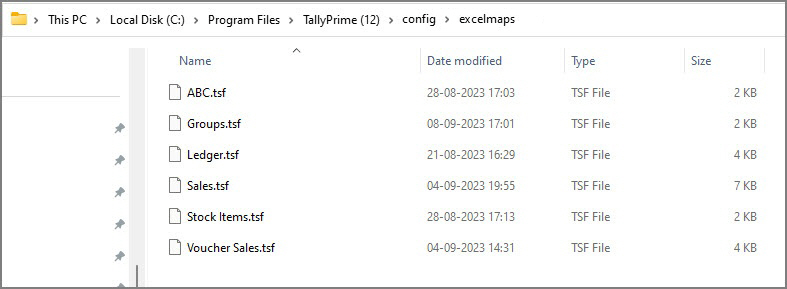
Just fill in the worksheet with relevant data based on your day-to-day transactions or master details, and import using the mapped templates. Isn’t that simple? Moreover, you can use the Excel files as is or make any necessary modifications to record data and alter the corresponding mapping files as needed.
If you are downloading the TSF files for Other Templates/Sample Excel Files for the first time, you must manually create the config > excelmaps folder under the TallyPrime installation folder.

Ensure that you check the Templates and Sample Excel Files and alter them according to the data that you want to import into TallyPrime.
You can create and customise your own template as per your business requirements and start the import process. You can manage the mapping template that you have created in TallyPrime. Similarly, if you have downloaded the Other Templates/Sample Excel File for mapping your data, you can manage those templates as well.
Let’s consider that you need to import the sales transactions data from the worksheet named Sales Bills from the Excel file Sales Transactions Q1.xlsx.

Depending on the Import configurations you have set, TallyPrime imports the data successfully.
The data that has been successfully imported is displayed in different reports in TallyPrime.
Data Exceptions in Import
If the data in the Excel has any exceptions or errors, TallyPrime completes the Import process, but with a few exceptions/errors. TallyPrime imports the data, and displays the following message:
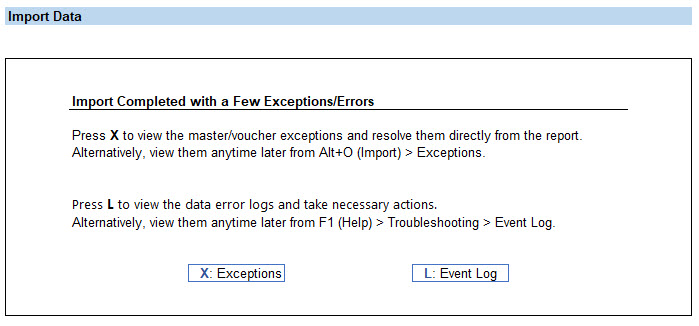
You also have the choice to either stop import of the data in the Import Configuration screen, if there is any exception or import data without recording any exception to avoid any risk of corrupting your existing data.
By default, TallyPrime will record the exceptions and proceed with the Import process.
While importing data, if any masters or transactions have any errors, the same is recorded either in the Exceptions Report or Event Log, depending on the type of error.
TallyPrime Release 4.0 helps you to create mapping templates for ease of importing data from Excel worksheets. Depending on the way you maintain the data in Excel file, you will need to create the mapping accordingly. Say the Excel worksheet does not have column headers, or you need to combine values from multiple cells, or calculate the nett amount for your transactions. Use the host of flexibilities with the mapping templates to ensure that such specific requirements can be handled easily.
In this section
Excel data with Column Headers
Consider that you have column headers for each column of data in the Excel file, as shown in the image below:

Note: To create a mapping template for ledgers, Name and Group of the ledgers are mandatory details.
The mapping template appears, as shown below:
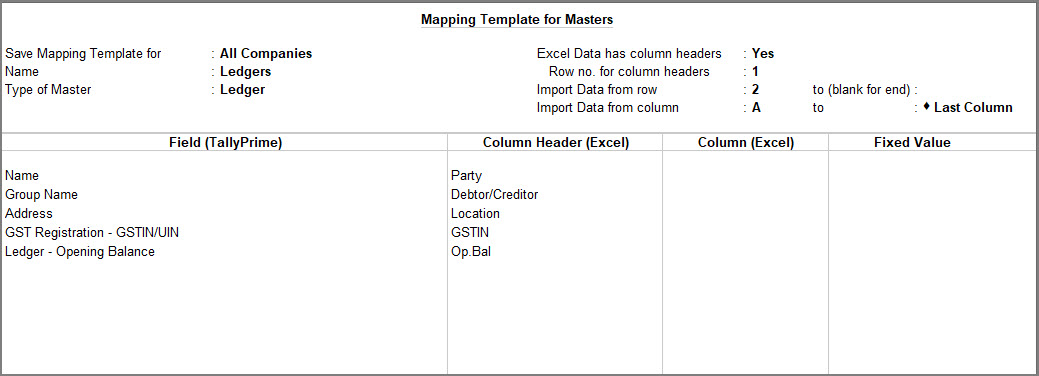
Excel data without Column Headers
If any column in the Excel does not have a column header, you can specify the column while mapping. For instance, the Excel file shown below does not have any column header.

In the Mapping Template for Masters,
The mapping template appears, as shown below:

You might have Opening Balance stored in multiple columns, with or without column headers in the Excel file. Similarly, you might want to compute values from different columns in the Excel worksheet. In such cases, you can use the Compute Value mapping options for importing such data.
Compute Value where field value will be Nett Amount
Opening Balance in different columns for debit & credit | Compute Value using Cr/Dr
Let’s say you maintain an Excel sheet for entering the opening balances of your party accounts. You have separate columns for entering the debit and credit amount for each party and you want to import this list into TallyPrime.
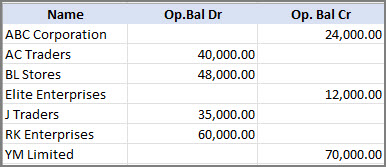
In the Mapping Template Creation screen,
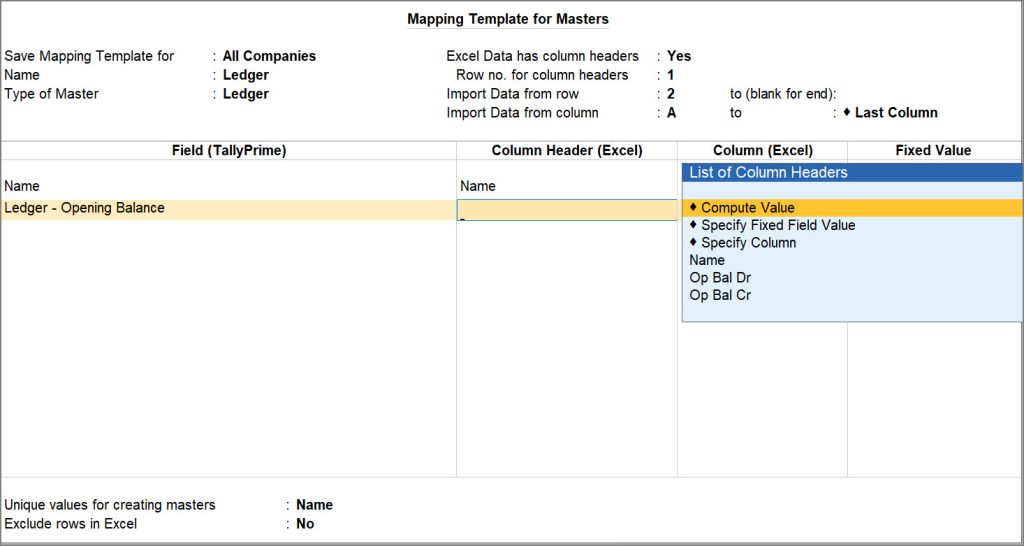


Opening Balance with debit & credit as cell value | Compute Value as per Cell Value
In the Excel file, you may have mentioned whether the value is Dr or Cr just beside the Opening Balances.
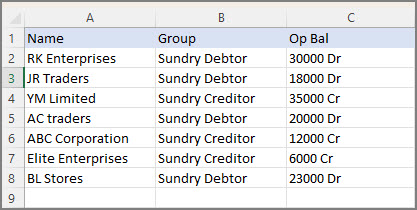
In this case, simply selecting the As per Cell Value option will import the data as mentioned in the cell in the Excel file.
Opening Balance with specific column headers for debit & credit | Compute Value as per Column Headers
Similarly, if you have put the data under specific headers, selecting the As per Column Headers option will prompt the system to consider the values as they are specified under the Column Headers and do the mapping.
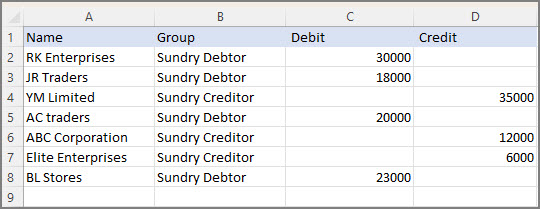
Selecting the Column Headers Debit and Credit will import all the values under them.
Combine values where field value will be a combination of multiple cell values
Let’s say that you have maintained stock item details in Excel sheet as follows:
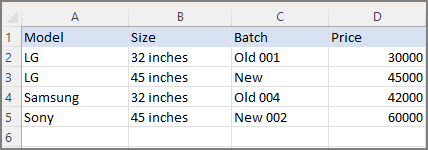
In case you want to use the details from the Column Headers Model and Size as the stock item name, you can map using the Compute Value option in the Import process.
In the Mapping Template Creation screen,
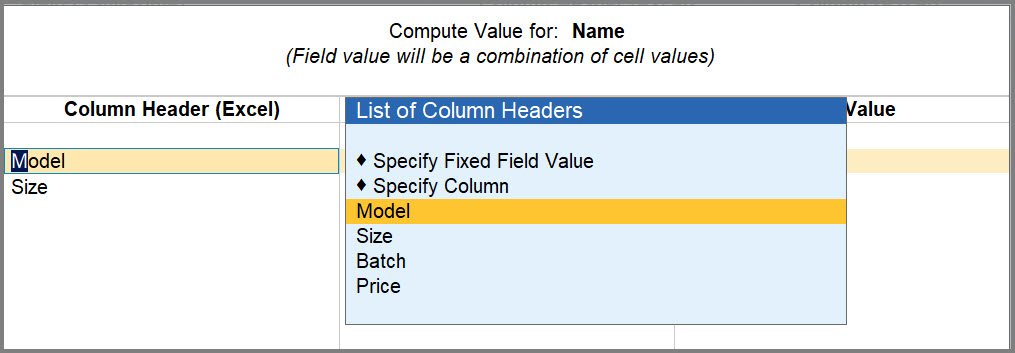

Compute values where field value will be set to Yes
There are certain fields in TallyPrime that accept only Yes/No as the input, like Maintain Balances bill-by-bill, Cost centres are applicable and more.
In you Excel file, you may have entered values other than Yes/No which you want to map with the fields in TallyPrime.
Let’s say your Excel file has data as follows and you want to map the value for Maintain balances bill-by-bill:

In the Compute Value for: screen,

By using this option, you can easily map your Excel data to TallyPrime fields that accept logical values like Yes or No.
This capability simplifies the process of importing data and ensures that your data is correct and consistent within TallyPrime.
Let’s say you have entered details of multiple parties in an Excel file, without specifying their Group, as they all belong to the same group – Sundry Debtors.

However, as you know that Group Name is mandatory during ledger entry, while importing you will need to specify the Group for the ledgers. You can use the Specify Fixed Field Value option while mapping the data to import such masters easily.
In the Mapping Template for Masters,

As a result, all the parties in your Excel file will be systematically assigned to the specified group in TallyPrime, simplifying the data import process and ensuring that your ledger details are accurately organized for the import process.
Based on the parameters you select for creating the uniqueness, the masters or transactions will be created. When you import masters from an Excel file, TallyPrime by default creates masters based on each unique master Name.
Similarly, when you import vouchers from an Excel file, TallyPrime by default creates vouchers based on each unique Voucher Type Name, Voucher Date and Voucher Number.
However, you can choose the unique values based on which the masters or transactions should be created when importing data. Once you have mapped the fields with the Excel file, select the required option under Unique values for creating masters > Additional Options.

In case you do not see this option in the mapping template, press F12 (Configure) > Show Additional Options for creating Masters > Yes.
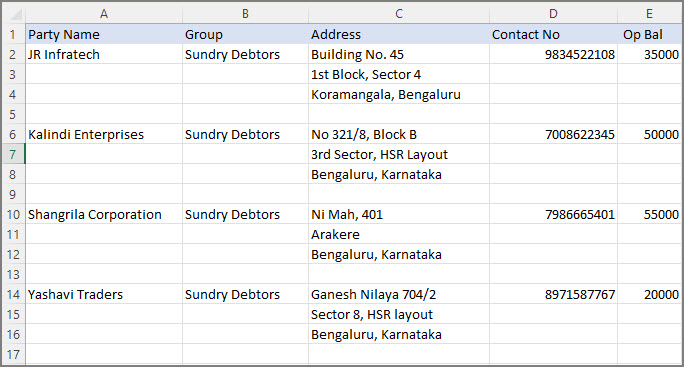
On selecting this option and importing data, TallyPrime will use the data until each blank row to create a master.

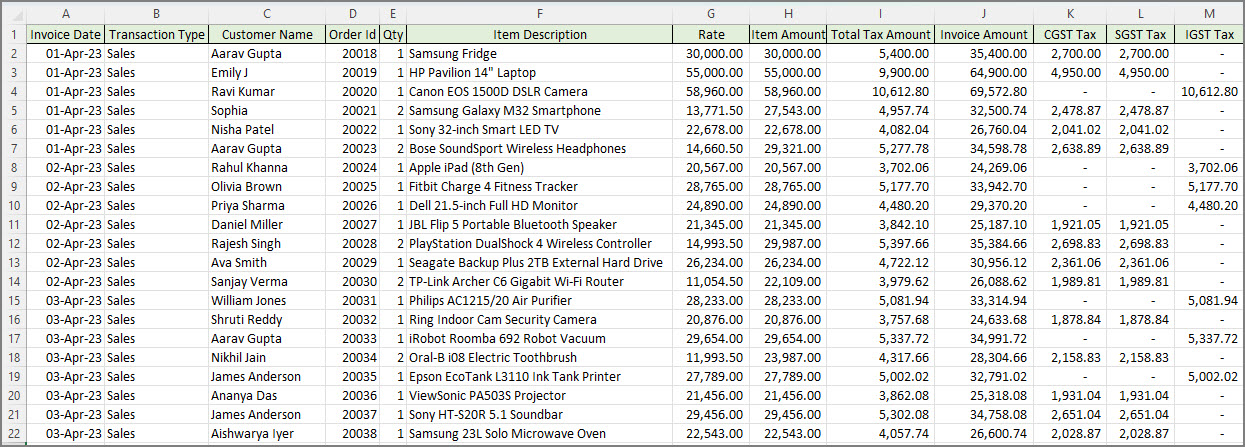
The availability of additional options for creating masters or transactions adds flexibility and customization to the import process. These options enable you to tailor the uniqueness criteria to your specific needs, making it easier to import and manage data effectively.

You can specify the conditions based on which data from one or more rows should be excluded while importing the data. Let’s say you have entered transaction details with parties in an Excel worksheet in the following manner:

You want to exclude rows that contain the entries for Sunday.
In the Mapping Template Creation screen,

You can select more than one Column Header or more conditions for the same Column Header for excluding rows in the Excel worksheet.
By using this option, you can easily set conditions to filter out unwanted data during the import process. Whether you need to exclude rows based on dates, specific values, or other criteria, TallyPrime empowers you to tailor your data for importing.

After saving a mapping template, you can alter the same in the Mapping Template Alteration screen. For example, you may have created a mapping template for the list of Stock items in Excel and now you want to alter the row number from which you want to import the data from.

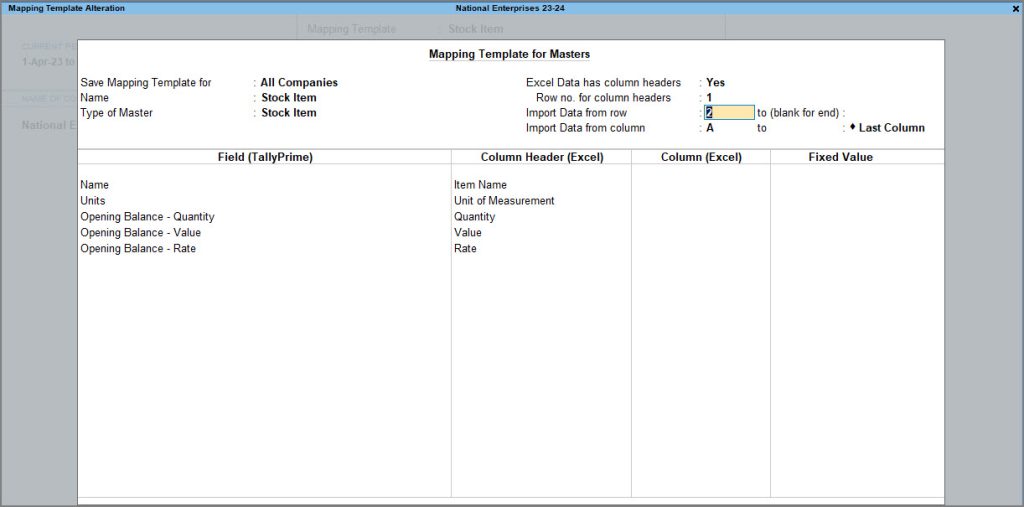
In conclusion, this feature provides a convenient and flexible way to modify your mapping templates as needed. Once the alterations have been made, you can easily save the updated mapping template, ensuring that your data import processes remain accurate and efficient.
You can delete a specific mapping template in case you do not require it any further, in just a few simple steps.
However, TallyPrime provides you the flexibility of deleting the mapping templates saved for either All Companies or This Company in your TallyPrime.
In this section
Delete Mapping Templates saved for All Companies

You can delete the mapping templates saved for All Companies in your TallyPrime.
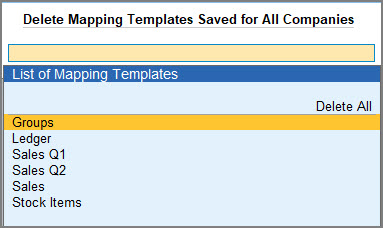

The selected mapping template will be deleted for all companies.
Similarly, you can also delete all the mapping templates saved for all companies at one go.


Whether you need to delete a single mapping template or clear out all templates associated with all companies in your TallyPrime, the process is quick and easy to execute.
Delete Mapping Templates saved for This Company

You can delete a mapping template saved only for the company that is currently loaded in your TallyPrime.
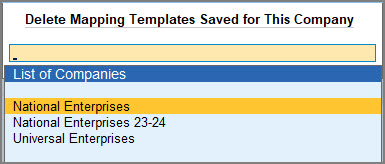
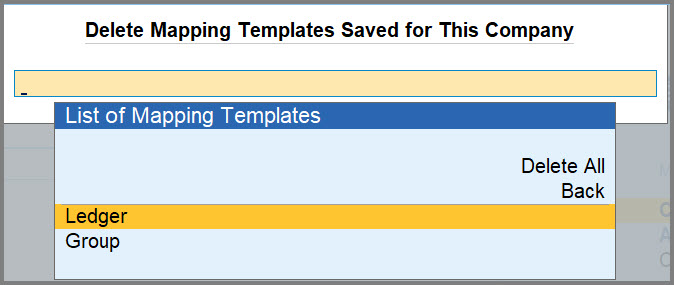

The selected mapping template will be deleted for the company that you have selected.
You can also delete all the mapping templates saved for the company at one go.
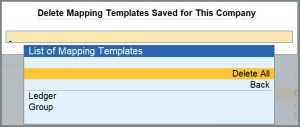

TallyPrime offers an efficient and flexible way to manage your mapping templates, giving you the ability to delete templates as needed. This feature allows you to maintain a well-organized and clutter-free workspace within TallyPrime, ensuring that your data import processes remain streamlined and efficient.
You may have recorded your masters and transactions in an external software or have a company created in an older version of TallyPrime. Now, you might want to move the data into the newest version of TallyPrime. You can utilise the TallyPrime’s Import feature and get your job done in a few simple steps. All that you have to do is, export the required masters and transactions into an XML file and then import it back into TallyPrime. When you export any data from other company or software, and want to import the same data into TallyPrime, ensure to save it in XML file format.
Note: The company features that were enabled while exporting the data should be enabled in the company in which the data is imported.
Let us consider that you want to import masters created in National Enterprises (Bangalore) to a new company – National Enterprises (Chennai). The options Maintain stock categories and Maintain batch-wise details must have been enabled in National Enterprises (Bangalore) before exporting the masters. To import masters into National Enterprises (Chennai), you need to ensure that both the options Maintain stock categories and Maintain batch-wise details are enabled in National Enterprises (Chennai) before importing.
In this section
File Path: Enter the location where your Data is stored in XML file format.
By default, the export location is the TallyPrime installation folder, which is also the default import location. Therefore, it is not required to specify the file path during import.
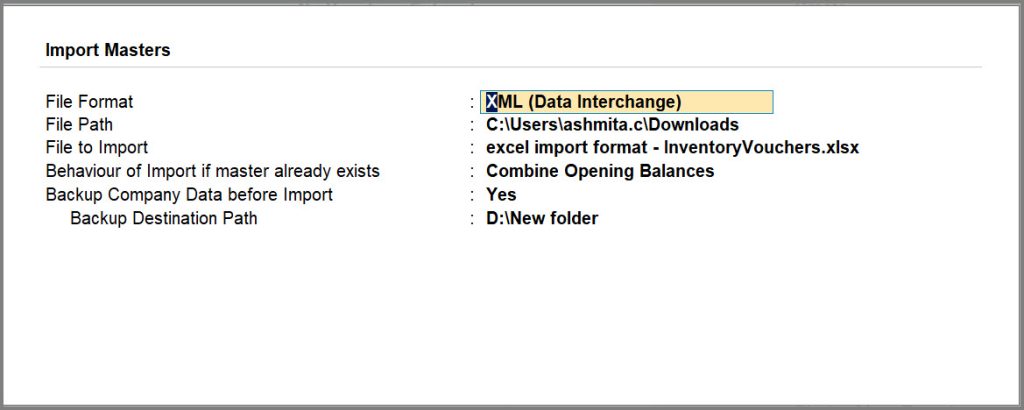
Depending on the Import configurations you have set, TallyPrime imports the data.
If you are using TallyPrime Release 3.0.1 or earlier, click here.
In MARG, you have an option to export the masters and transactions in MARG to TallyPrime.
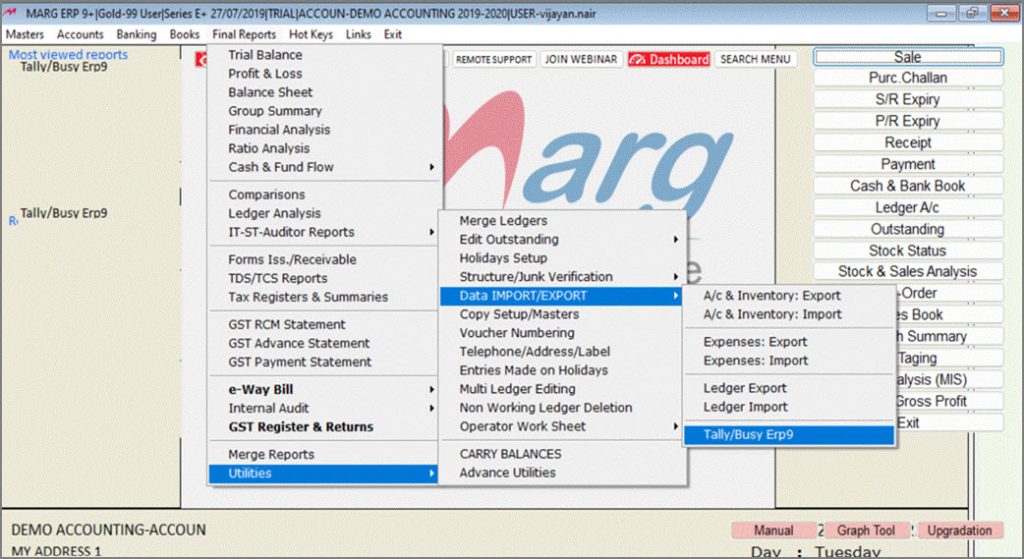
Data from masters and transactions from Marg will be exported in XML format. You can import the same XML file to TallyPrime.
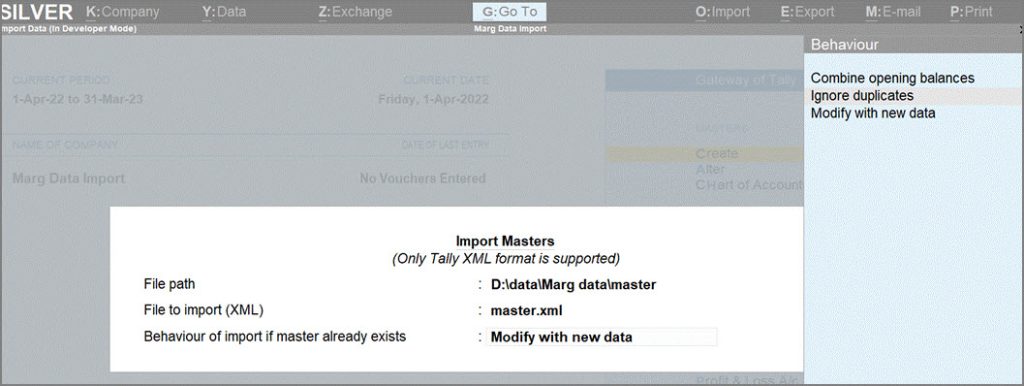
You can check the statistics after importing masters and transactions.
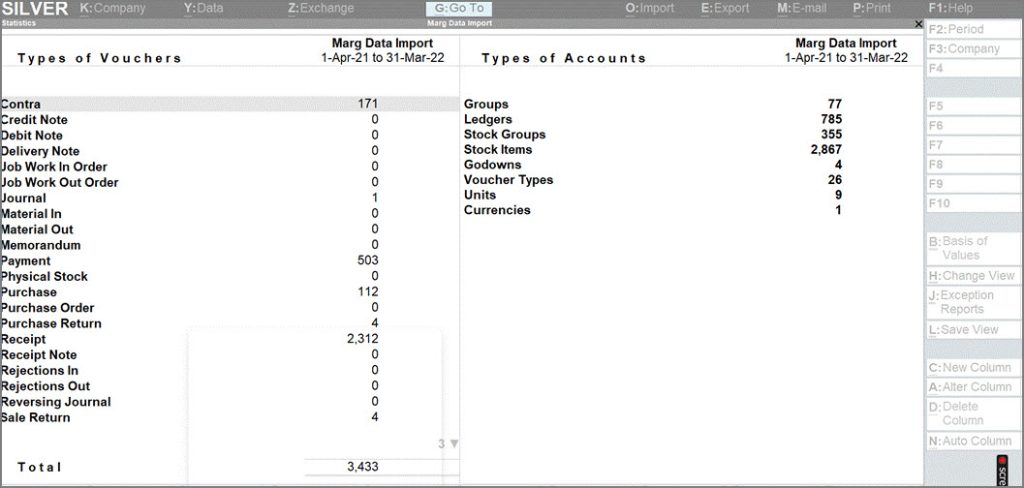
In conclusion, the ability to import data into TallyPrime from external sources like Excel and XML files significantly simplifies the process of maintaining accurate and up-to-date business records. This import feature not only saves your valuable time but also reduces the risk of errors that can occur during manual data entry. So, whether you are a business owner, an accountant, or a financial professional, utilise the power of TallyPrime’s Import feature to ensure the seamless flow of data and enhance your overall business efficiency.
Source URL: https://help.tallysolutions.com/tally-prime/data-exchange-tally-prime/import-data-in-tally/
Applicable for CAs / Firms Using GOLD (Multi User ) Only
Renew your license now and upgrade from Tally ERP 9 to Tally Prime for Free!₹ 6750 + 18% GST (₹ 1215)
Applicable for CAs / Firms Using GOLD (Multi User ) Only
Renew your license now and upgrade from Tally ERP 9 to Tally Prime for Free!
₹ 12150
+ 18% GST (₹ 2187)

Unlimited Multi-User Edition For Multiple PCs on LAN Environment
Renew your license now and upgrade from Tally ERP 9 to Tally Prime for Free!₹ 13500 + 18% GST (₹ 2430)
Unlimited Multi-User Edition For Multiple PCs on LAN Environment
Renew your license now and upgrade from Tally ERP 9 to Tally Prime for Free!
₹ 24300
+ 18% GST (₹ 4374)

Single User Edition For Standalone PCs ( Not applicable for Rental License )
Renew your license now and upgrade from Tally ERP 9 to Tally Prime for Free!₹ 4500 + 18% GST (₹ 810)
Single User Edition For Standalone PCs ( Not applicable for Rental License )
Renew your license now and upgrade from Tally ERP 9 to Tally Prime for Free!
₹ 8100
+ 18% GST (₹ 1458)

Tally On Cloud ( Per User Annual)
Now access Tally Prime anytime from anywhere – Just Deploy your Tally License and Tally Data on our Cloud Solution.₹ 7000 + 18% GST (₹ 1260)
Unlimited Multi-User Edition
For EMI options, please Call: +91 742 877 9101 or E-mail: tally@binarysoft.com (10:00 am – 6: 00 pm , Mon-Fri)₹ 67500 + 18% GST (₹ 12150)
Unlimited Multi-User Edition For Multiple PCs on LAN Environment
Renew your license now and upgrade from Tally ERP 9 to Tally Prime for Free!₹ 45000 + 18% GST (₹ 8100)
Single User Edition For Standalone PCs
For EMI options, please Call: +91 742 877 9101 or E-mail: tally@binarysoft.com (10:00 am – 6: 00 pm , Mon-Fri)₹ 22500 + 18% GST (₹ 4050)
(Per User/One Year)
TallyPrime latest release pre-installed₹ 7200 + 18% GST (₹ 1296)
(Two Users/One Year)
TallyPrime latest release pre-installed₹ 14400 + 18% GST (₹ 2592)
(Four Users/One Year)
TallyPrime latest release pre-installed₹ 21600 + 18% GST (₹ 3888)
(Eight Users/One Year )
TallyPrime latest release pre-installed₹ 43200 + 18% GST (₹ 7776)
(Twelve Users/One Year)
TallyPrime latest release pre-installed₹ 64800 + 18% GST (₹ 11664)
(Sixteen Users/One Year)
TallyPrime latest release pre-installed₹ 86400 + 18% GST (₹ 15552)